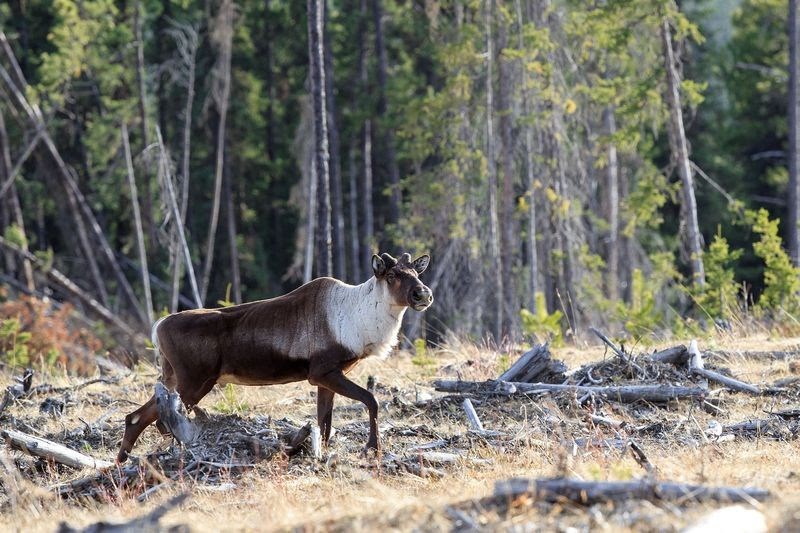Eco groups say the province of Alberta just isn’t doing what it promised to when it comes to caribou conservation.
Four organizations – namely the Alberta Wilderness Association, the David Suzuki Foundation, the Mikisew Cree First Nation, and the Northern Alberta chapter of Canadian Parks and Wilderness Society (CPAWS) – recently issued a public statement calling out the government for not honouring the voluntary conservation agreements that it signed with the federal government.
Under Section 11 of the federal Species at Risk Act (SARA), voluntary conservation agreements are recommended to "benefit a species at risk or enhance its survival in the wild.” To date, seven conservation agreements have been signed between the federal government and provinces. Alberta and Ontario are the first for which progress reports have been released
Because of this, Alberta is failing to protect and recover threatened caribou populations as recent progress reports show.
David Suzuki Foundation boreal project manager Rachel Plotkin has been working to try to protect species at risk for more than 20 years. She no longer has the same optimism that she did when SARA was first brought into force.
“I personally don't think that the conservation agreements with the provinces are fulfilling that obligation,” she said.
“Habitat destruction is still occurring. And in fact, in both Alberta and Ontario, caribou are continuing to decline. In Alberta, there's populations that just have scraps of good habitat left, and they're still logging and oil and gas exploration activities that's happening in them.”
Reports from both provinces show that their recovery actions are falling way short while industrial activity in caribou habitat expands.
The Government of Alberta released its “First report on the implementation of the Section 11 Agreement for the conservation and recovery of the woodland caribou in Alberta” in January. It was the first step to be taken after the Section 11 Agreement (formally known as the Agreement for the Conservation and Recovery of the Woodland Caribou in Alberta) was signed between the province and the federal government in October 2020, covering a five-year timespan.
Federal directives to establish limits on habitat disturbance have been ignored, the four groups say. The maximum 35 per cent of disturbed habitat threshold (as outlined in the federal recovery strategy) has been surpassed in all of Alberta’s 15 caribou ranges on provincial public lands.
Six of those ranges have less than 10 per cent of undisturbed habitat remaining.
Across Alberta, less than one per cent of the 209,000 kilometres of legacy seismic lines (as identified for restoration in the 2022-23 report) has been restored.
It doesn’t paint a pretty picture for how seriously this province weighs environmental concerns against industrial ones.
“I think the oil and gas and forestry rule the day in Alberta,” Plotkin said.
“It's a very discouraging file. As someone who's worked on trying to protect species at risk, sometimes you think what will it take? The Little Smoky range, we've lost over 99 per cent of the undisturbed habitat, and they're still approving oil and gas and logging in it.”
Approvals for forestry, energy, mining and linear disturbance in 2022 and 2023 reportedly added nearly 56,000 has of human footprint in caribou ranges in Alberta.
While the province continues to approve new habitat disturbance, it also supports the most intensive wolf cull program in the country as an artificial way of boosting caribou populations. A recent study published in the journal Biological Conservation suggests that surviving members of a wolf pack could quickly learn to avoid future threats, making the problem even worse by having unintended consequences on caribou and their habitats.
Still, the root cause of caribou decline is habitat loss and fragmentation.
Alberta relies on the 2020 Liability Management Framework to address inactive and orphaned gas well restoration within caribou habitat. It remains unclear if any of its mechanisms are sufficient for closure and restoration to occur fast enough for what’s needed to facilitate caribou recovery.
CPAWS Northern Alberta program director Tara Russell added that the combined lack of progress, long timelines, new industrial disturbance approvals and constant delays for land-use planning all contribute to making Alberta's commitment to caribou recovery look like lip service.
“These reports highlight the dismal amount of progress made for caribou in the province,” she said.
According to Alberta’s first progress report in January, caribou in mountain ranges “have demonstrated dramatic declines in range level occupancy and distribution.” This is particularly evident for caribou populations in west-central Alberta, with large declines in distribution evident for the Redrock-Prairie Creek, as well as both the Narraway and Little Smoky populations whose habitats are around Grande Cache.
This habitat change is also causing the Redrock-Prairie Creek, Narraway and À la Pêche (the latter two from Grande Cache) populations to demonstrate increasingly reduced annual migration to their traditional winter ranges in the forested foothills. This keeps them more and more restricted to mountainous areas year-round, despite these areas being considered suboptimal winter habitat for them.
Plotkin said that no matter how far the province has gone backward, it can always turn things around.
“There are ways forward. It requires a fairly significant systemic change in how we look at forest and forest management and forest stewardship and our responsibility to recover wildlife. But it is possible.”



